with的复合结构
- 格式:ppt
- 大小:137.01 KB
- 文档页数:28
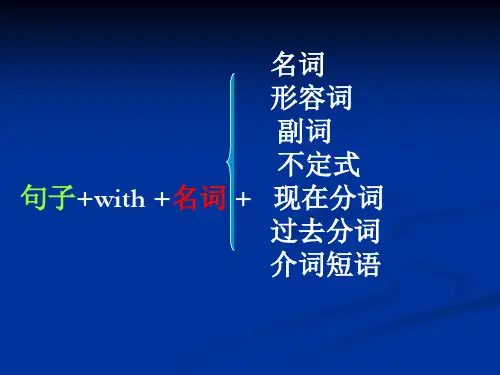


with结构也称为with复合结构,是由with+复合宾语(宾语+宾语补足语)组成一. with复合结构在句中做状语,表示谓语动作发生的伴随情况、时间、原因、方式等.其构成有下列几种情形:1、with + 名词 (或代词) + 现在分词此时,现在分词和前面的名词或代词是逻辑上的主谓关系.例如:With prices going up so fast,we can't afford luxuries.由于物价上涨很快,我们买不起高档商品.(原因状语)With the crowds cheering,they drove to the palace.在人群的欢呼声中,他们驱车来到皇宫.(伴随情况) With the bay leading the way,I found the village easily.2、with + 名词 (或代词) + 过去分词此时,过去分词和前面的名词或代词是逻辑上的动宾关系.例如:I sat in my room for a few minutes with my eyes fixed on the ceiling.我在房间坐了一会儿,眼睛盯着天花板.(伴随情况)She had to walk home with her bike stolen.自行车被偷,她只好步行回家.(原因状语)3、with + 名词 (或代词) + 形容词I like to sleep with the windows open.我喜欢把窗户开着睡觉.(伴随情况)With the weather so close and stuffy,ten to one it'll rain presently.大气这样闷,十之八九要下雨.(原因状语)4、with + 名词 (或代词) + 介词短语With the children at school,we can't take our vacation when we want to.由于孩子们在上学,所以当我们想度假时而不能去度假.(原因状语)The professor came in with a book in his hand(伴随状语)5、with + 名词 (或代词) + 副词He fell asleep with the light on.他睡着了,灯还亮着.(伴随情况)The boy stood there with his head down.这个男孩低头站在那儿.(伴随情况)John was lying on the bed with all his clothes on.6 、with + 名词 (或代词) + 动词不定式此时,不定式表示将发生的动作.例如:With no one to talk to,John felt miserable.由于没人可以说话的人,约翰感到很悲哀.(原因状语)With a lot of work to do,he wasn't allowed to go out.因为还有很多工作要做,他没有被允许外出.(原因状语)在with without 的复合结构中,多数情况下with 能省略,但without 不能省略。
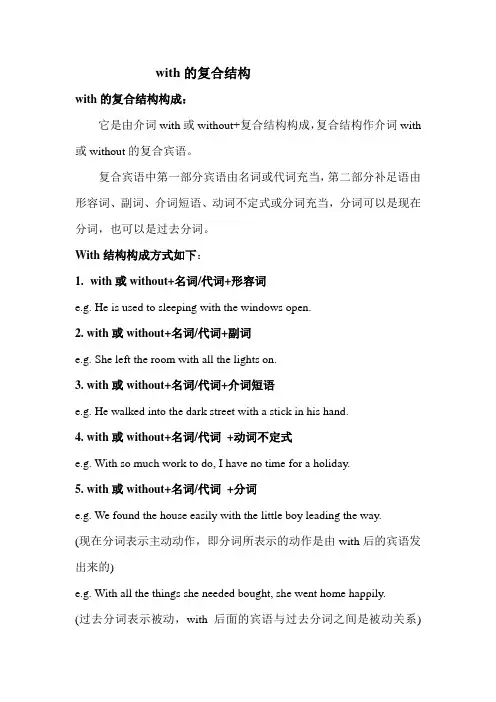
with的复合结构with的复合结构构成:它是由介词with或without+复合结构构成,复合结构作介词with 或without的复合宾语。
复合宾语中第一部分宾语由名词或代词充当,第二部分补足语由形容词、副词、介词短语、动词不定式或分词充当,分词可以是现在分词,也可以是过去分词。
With结构构成方式如下:1.with或without+名词/代词+形容词e.g. He is used to sleeping with the windows open.2. with或without+名词/代词+副词e.g. She left the room with all the lights on.3. with或without+名词/代词+介词短语e.g. He walked into the dark street with a stick in his hand.4. with或without+名词/代词+动词不定式e.g. With so much work to do, I have no time for a holiday.5. with或without+名词/代词+分词e.g. We found the house easily with the little boy leading the way.(现在分词表示主动动作,即分词所表示的动作是由with后的宾语发出来的)e.g. With all the things she needed bought, she went home happily.(过去分词表示被动,with后面的宾语与过去分词之间是被动关系)6. without+名词/代词+补语e.g. Possibly this person died without anyone knowing where the coins were hidden.e.g. He wondered if he could slide out of the lecture hall without anyone noticing (him).7. with+不定式和+分词的区别加不定式是指将要进行的动作,加分词是指主动或被动动作.with复合结构的句法功能1.with 复合结构,在句中表状态或说明背景情况,常做伴随、方式、原因、条件等状语。


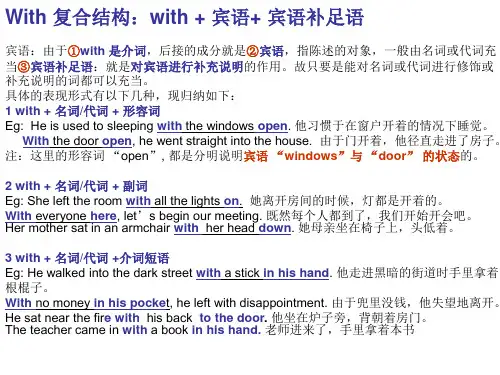
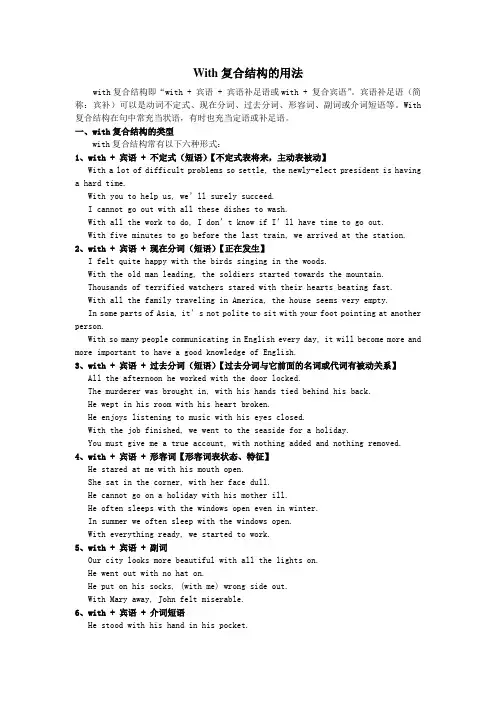
With复合结构的用法with复合结构即“with + 宾语 + 宾语补足语或with + 复合宾语”。
宾语补足语(简称:宾补)可以是动词不定式、现在分词、过去分词、形容词、副词或介词短语等。
With 复合结构在句中常充当状语,有时也充当定语或补足语。
一、with复合结构的类型with复合结构常有以下六种形式:1、with + 宾语 + 不定式(短语)【不定式表将来,主动表被动】With a lot of difficult problems so settle, the newly-elect president is having a hard time.With you to help us, we’ll surely succeed.I cannot go out with all these dishes to wash.With all the work to do, I don’t know if I’ll have time to go out.With five minutes to go before the last train, we arrived at the station.2、with + 宾语 + 现在分词(短语)【正在发生】I felt quite happy with the birds singing in the woods.With the old man leading, the soldiers started towards the mountain.Thousands of terrified watchers stared with their hearts beating fast.With all the family traveling in America, the house seems very empty.In some parts of Asia, it’s not polite to sit with your foot pointing at another person.With so many people communicating in English every day, it will become more and more important to have a good knowledge of English.3、with + 宾语 + 过去分词(短语)【过去分词与它前面的名词或代词有被动关系】All the afternoon he worked with the door locked.The murderer was brought in, with his hands tied behind his back.He wept in his room with his heart broken.He enjoys listening to music with his eyes closed.With the job finished, we went to the seaside for a holiday.You must give me a true account, with nothing added and nothing removed.4、with + 宾语 + 形容词【形容词表状态、特征】He stared at me with his mouth open.She sat in the corner, with her face dull.He cannot go on a holiday with his mother ill.He often sleeps with the windows open even in winter.In summer we often sleep with the windows open.With everything ready, we started to work.5、with + 宾语 + 副词Our city looks more beautiful with all the lights on.He went out with no hat on.He put on his socks, (with me) wrong side out.With Mary away, John felt miserable.6、with + 宾语 + 介词短语He stood with his hand in his pocket.He was asleep with his head on his arms.The teacher stood here with a book in her hand.The teacher walked into the classroom with a ruler under his arm.The guard rushed out with a gun in his hand.二、with复合结构的用法with复合结构主要用来说明附带情况或具体细节,在句中主要用作状语,有时也用作定语、宾语补足语或主语补足语。
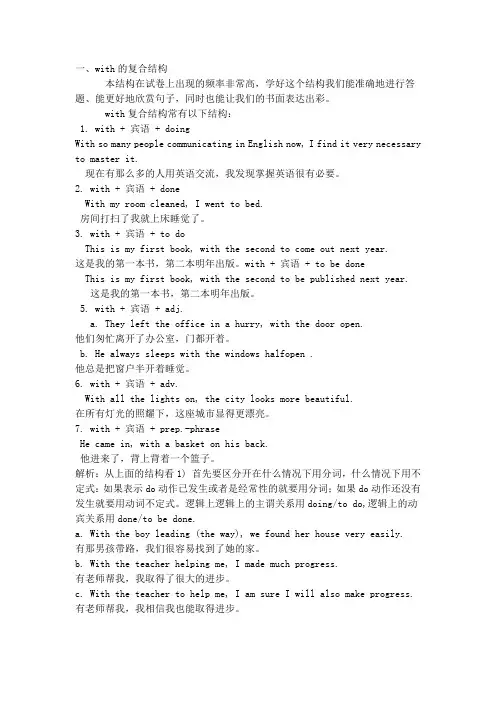
一、with的复合结构本结构在试卷上出现的频率非常高,学好这个结构我们能准确地进行答题、能更好地欣赏句子,同时也能让我们的书面表达出彩。
with复合结构常有以下结构:1. with + 宾语 + doingWith so many people communicating in English now, I find it very necessary to master it.现在有那么多的人用英语交流,我发现掌握英语很有必要。
2. with + 宾语 + doneWith my room cleaned, I went to bed.房间打扫了我就上床睡觉了。
3. with + 宾语 + to doThis is my first book, with the second to come out next year.这是我的第一本书,第二本明年出版。
with + 宾语 + to be doneThis is my first book, with the second to be published next year.这是我的第一本书,第二本明年出版。
5. with + 宾语 + adj.a. They left the office in a hurry, with the door open.他们匆忙离开了办公室,门都开着。
b. He always sleeps with the windows halfopen .他总是把窗户半开着睡觉。
6. with + 宾语 + adv.With all the lights on, the city looks more beautiful.在所有灯光的照耀下,这座城市显得更漂亮。
7. with + 宾语 + prep.-phraseHe came in, with a basket on his back.他进来了,背上背着一个篮子。
解析:从上面的结构看1) 首先要区分开在什么情况下用分词,什么情况下用不定式:如果表示do动作已发生或者是经常性的就要用分词;如果do动作还没有发生就要用动词不定式。
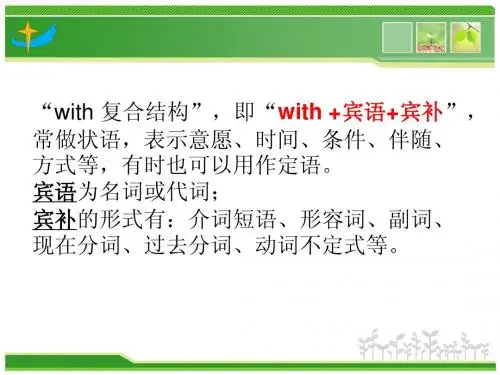
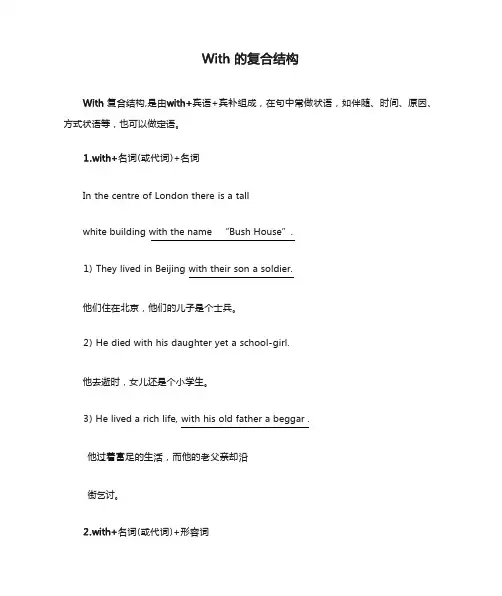
复合结构,宾语+宾补组成,在句中常做状语,如伴随、时间、原因、方式状语等,也可以做定语。
(或代词)+名词In the centre of London there is a tallwhite building with the name “Bush House”.1) They lived in Beijing with their son a soldier.他们住在北京,他们的儿子是个士兵。
2) He died with his daughter yet a school-girl.他去逝时,女儿还是个小学生。
3) He lived a rich life, with his old father a beggar .他过着富足的生活,而他的老父亲却沿街乞讨。
名词(或代词)+形容词强调名词的特性或状态She came into the room ,with her nose red because of cold.我喜欢把窗户开着睡觉。
(伴))嘴里有食物时不要讲话。
(伴)(或代词)+副词With the meal over , we all went home.他睡着了,灯还亮着。
(伴)这个男孩低头站在那儿。
(伴)名词(或代词)+动词不定式此时,不定式表示将发生的动作。
With the boy to lead the way ,we will find the house easily tomorrow.由于没人可以说话的人,约翰感到很焦虑。
(原)因为还有很多工作要做,他没有被允许外出。
(原)(或代词)+现在分词现在分词和前面的名词或代词是逻辑上的主谓关系。
With the boy leading the way ,we foundhe house easily.(原)(伴)(伴)(或代词)+过去分词过去分词和前面的名词或代词是逻辑上的动宾关系。
With my homework finished(=After I finished my homework) ,I went fishing withmy father.我在房间坐了一会儿,眼睛盯着天花(伴)自行车被偷,她只好步行回家。
with的复合结构与expect
"with"的复合结构是指以介词"with"开头,后面跟着动词-ing形式的短语,用来表示伴随、关联、原因等关系。
例如:with a smile(带着微笑)、with great interest(充满兴趣地)。
"expect"是表示期望、预计的动词,用于表达对某事发生的预期或对某人有期望。
它可以接一个宾语,表示期待的对象。
例如:I am expecting a package to arrive tomorrow(我期待明天收到一个包裹)。
在语法上,"expect"可以和"with"一起使用,但具体用法要根据句子的语境来确定。
例如:I expect to see you with a smile(我期待见到你时你带着微笑)。
需要注意的是,本回答仅针对语法和用法解释,并无法提供关于具体事件或情况的判断、预测。
With的复合结构With复合结构,是由with+宾语+宾补组成,在句中常做状语,如伴随、时间、原因、方式状语等,也可以做定语。
1.with+名词(或代词)+名词there is a tallng am “B s H s ”.B g s a s r.他们住在北京,他们的儿子是个士兵。
2) He died s a a s -girl.他去逝时,女儿还是个小学生。
3) He lived a rich life, s a a a .他过着富足的生活,而他的老父亲却沿街乞讨。
2.with+名词(或代词)+形容词强调名词的特性或状态She came into the room,with her nose red a s e of cold.1s open.我喜欢把窗户开着睡觉。
(伴)2) D ’ a with your mouth full.嘴里有食物时不要讲话。
(伴)3.with+名词(或代词)+副词With the meal over ,we all went home.a with the light on.他睡着了,灯还亮着。
(伴)2) The boy stood there with his head down.这个男孩低头站在那儿。
(伴)4.with+名词(或代词)+介词短语Do you know the woman with a baby in her arms(=who has ababy in her arms)?a a a a a on when we want to.由于孩子们在上学,所以当我们想度假时而不能去度假。
(原)a a a a .士兵让他背朝着他的父亲站在那儿。
(方)5.with+名词(或代词)+动词不定式此时,不定式表示将发生的动作。
With the boy to lead the way,we will find the house easm ow.1) With no one to talk to, John felt upset.由于没人可以说话的人,约翰感到很焦虑。
1 With 的复合结构(with+ 复合宾语)with+ 复合宾语结构常作原因状语、伴随状语、定语等。
With + 名词/代词+名词With + 名词/代词+形容词With + 名词/代词+副词With + 名词/代词+介词短语With + 名词/代词+不定式(to do/ to be done 表示动作将要做, 若句中主语发出动作,用to do , 若句中主语不发出这一动作,则用to be doneWith + 名词/代词+现在分词(doing/ being done 表示动作与谓语动词同时进行,若是with 后的名词/代词发出动作,即所谓的主动,则用doing ; 若是被动,则用being done )With + 名词/代词+过去分词(动作已结束,动词与前面名词/代词的关系是被动) He left home, with his wife a hopeless soul.She used to sleep with the windows open.She used to sleep with the light on.She came in, with a book in her hand.With all the work to do, I don’t know if I’ll have time to go out.With the boy leading us, we soon found the house.With the house being painted, we can’t move in.With everything I needed bought, I left the shop.2 独立主格结构一般来说,我们把With 复合结构中的with 去掉,就成了独立主格结构了。
如:She slept, the windows open.The prisoner stood there, his hands raised. ( 可以这样理解:hand 是被举起的,表示被动和完成)Time permitting, We ‘ll go for a picnic.(time和permit 是主动关系)She came in, book in hand. (注: book 和hand 之前不加任何代词或冠词,这与with 复合结构不同)还有不同的是,独立主格中出现了beingIt being a fine day, we decided to go swimming.There being no bus, I had to go home on foot.这两句话中的being 是由动词be 变来的,可以这样想:独立主格也是状语,所以不能使用谓语动词。
介词with的复合结构with复合结构是英语中非常重要的语法知识,也是高中英语考试常考的知识点。
With复合结构在句子中的功能有两种:一种是表状态或者说明背景情况,充当时间状语、原因状语、条件状语、伴随状语等;另一种功能是起修饰限定作用,在句中充当定语。
with复合结构的构成:1.With + 名词+ 介词短语2.with + 名词+ 形容词(强调名词的特性或状态)3. With + 名词+ 副词4. With + 名词+ -ed 分词(强调名词是-ed分词动作的承受者或动作已经发生)5. with + 名词+ -ing分词(强调名词是-ing分词的动作的发出者或某动作,状态正在进行)6. with + 名词+ to do (不定式动作尚未发生)with复合结构的用法:I. with复合结构作状语1 With + 名词+ 介词短语(1)他头枕在胳膊上睡了。
He was asleep with his head on his arm. 作伴随状语(2)这人手里拿了一个鞭子进来了。
The man came in with a whip in his hand. 作伴随状语在书面语中。
上句也可以说成:The man came in, whip in hand.2.with + 名词+ 形容词(强调名词的特性或状态)(1)天气这么闷热,十之八九要下雨。
With the weather so close and stuffy, ten to one it 'll rain presently. 作原因状语(2)他过去常常窗子开着睡觉。
He used to sleep with the windows open. 作伴随状语3. With + 名词+ 副词(1)约翰走了,我们的地方大了一些With John away, we have got more room. 作原因状语(2)所有的灯都亮着,广场看上去比以往更漂亮了The square looks more beautiful than ever with all the lights on. 作原因状语4. With + 名词+ -ed 分词(强调名词是-ed分词动作的承受者或动作已经发生)(1) 随着这个问题的解决,新霉素一号现在已正式生产。